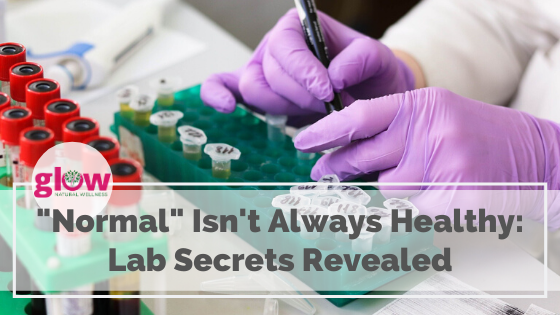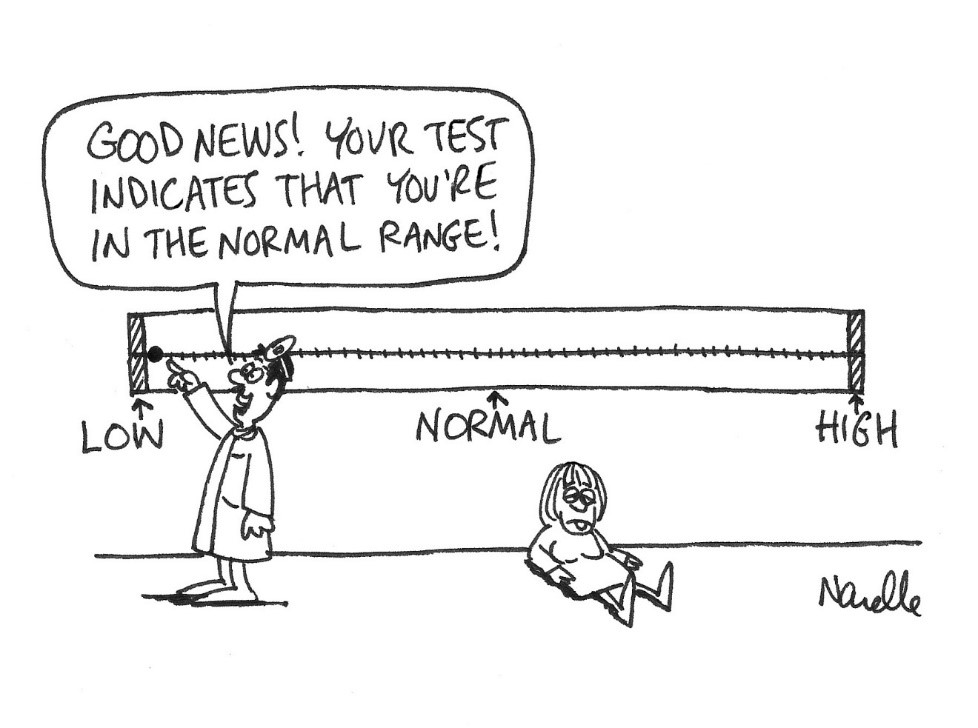

“Normal” Isn’t Always Healthy – Lab Secrets Revealed
There is one test that virtually everyone has had done (at least once in their life) by their medical doctors. It’s the gold standard for testing in the US, and the go-to test for clinicians of all specialties. Unfortunately, for most people, even those who don’t feel well, this test didn’t tell them much.
It’s a standard blood test. You know – CBC, Metabolic Panel, Vitamins, Liver Enzymes, Cholesterol…
The test that every doctor runs, but most doctors aren’t even using correctly.
In fact, 99% of my practice members tell me, “I’ve had my blood work done, and my doctor said the results came back normal.”
I hear this time and time again, but when I dig into their results, I see many abnormal signs of dysfunction, and healing opportunities to help resolve their symptoms.
You see, standard blood work can be one of our most valuable functional tools. But only when analyzed from a functional perspective.
One of the things to remember is that the majority of people who feel “unwell” will come out “normal” on a blood test. Clinical experience suggests that these people are by no means “normal” and are a far cry from being functionally optimal.
They may not yet have progressed to a known disease state (one we can name and give a diagnostic and insurance code) but they have what we call sub-clinical dysfunction. In other words, their physiological systems are no longer functioning properly, and they are starting to feel un-well.
Let’s take a look at some of the typical functional problems you might be experiencing:
- Fatigue and low energy,
- Digestive disorders such as bloating, heartburn, constipation and gas,
- Allergies
- Reduced immunity
- Infertility
- Pain and inflammation – muscle aches, stiffness, etc.
- Thyroid abnormalities – anything from full blown autoimmune thyroiditis (the most common autoimmune condition on the planet) to the myriad of signs and symptoms associated with a sluggish thyroid
- Sex Hormone issues ranging from erectile dysfunction, low libido, menstrual irregularities to struggles with going through menopause
- Sleep disturbances
- Anxiety or depression
- Weight fluctuations
- Hypertension and the range of issues associated with the cardiovascular system
- Cognitive impairment.
These are some of the typical signs and symptoms of a functional disturbance in the body.
However, many people with these symptoms present get their blood work back and are told “everything is in the normal range.”
This is a funny cartoon, but it’s not that funny if you are one of the people sitting slumped against the wall in your conventional medicine doc’s office, which is the experience of millions of people – including myself. Some days I didn’t even have the energy to get dressed to go see the doctor.
At GLOW Natural Wellness, we look through a slightly different lens, a lens that allows us to see what’s going on – not in terms of disease or pathology…. but in terms of dysfunction.
We are not looking for a disease state or a billable insurance diagnosis before we intervene. Instead, it is our goal to identify and remove dysfunction BEFORE it turns into disease, and in many cases, even before symptoms develop.
We see this all the time with thyroid markers. Women and men go to the doctor suffering from obvious thyroid symptoms – weight gain, hair loss, brain fog, feeling cold, anxious, fatigued, etc. They get their blood tested, and it comes back… normal.
Even when the doctor is testing the right thyroid markers.
For instance, Free T3 (which is the measure of how much active thyroid hormone is available) has a conventional reference range of 2.3-4.0.
This is what is considered normal.
However, in my clinical experience, anyone with a Free T3 reading under 2.9 is typically struggling, with the symptoms just mentioned, and therefore is dealing with subclinical hypothyroidism, and should have a treatment protocol (natural or otherwise) to help them feel “normal” again.
So, if you have a Free T3 of 2.5, you’ll be told you are normal, when you are actually suffering from subclinical hypothyroidism.
A traditional lab test report lacks meaning
Have you ever tried to read your blood test report?
It’s as if these reports are designed to be deliberately obscure and hard for the average person to understand. You get a long list of names (usually abbreviated), most of which you’ve never heard of, a long list of numbers, an occasional “H” or “L”, then obscure units of measure.
Nothing about this provides meaning for you. So you have to depend on your physician’s interpretation, which is usually rushed and incomplete..
Receiving your blood test result back, with perhaps a few hand-written notes on it, does not extract the full value contained within the data.
Though this data can be a valuable guide to direct your personal health journey, most of the meaning suggested by the data is unfortunately lost when we are told “Everything is Normal”.
But there’s a big problem with normal
The majority of conventional, standard, or “normal” reference ranges are based on the distribution of a bell curve, which says that 95% of the population are “normal” and 2.5% of the population are above the “normal” range and 2.5% are below the “normal” range.
The “normal” range is based on statistics and not on whether a certain value represents “good” health or function. I know that sounds crazy.
Wait!… it gets even crazier…
The “normal” reference values change from year to year depending upon the prevalence of disease in the general population. As our population becomes more dysfunctional, unhealthy, and obese, the “normal” reference range gets wider and wider. This leaves a larger number of the population testing in a range that is considered “normal.”
Normal ranges also vary from state to state. What might be normal in Virginia may be abnormal in California.
“Normal” does not mean healthy or dysfunction free, it just means average.
Yet, it is standard practice for allopathic physicians to evaluate blood chemistry tests using these reference ranges, determining who is healthy and who is not. If a diagnosable disease state is not present, the patient is considered “healthy.” If your numbers are within the “normal” range, then you are told “everything is normal”. Normal in this case, is not the goal. Normal is not the same as optimal or healthy.
What you really want is “optimal” health as opposed to “normal” health.
The Functional “Optimal” Range
The functional approach to blood chemistry analysis is oriented around changes in physiology and not pathology.
We use ranges that are based on optimal function of the body’s systems and not the average of a “normal” population.
The reference range is smaller, so we increase our ability to detect patients with changes in physiological “function”.
The good news is that we can take a test that you have already run with your doctor, and already covered by insurance, and analyze it from a functional perspective. This test that was previously filed away as not very significant, can be your most valuable diagnostic tool and can help guide your next steps in your healing journey. If you don’t have a blood test, we can get you one ordered for an additional costs.
Recently, GLOW Natural Wellness has made Functional Blood Chemistry Analysis available to the public. You can click here to learn more about the service and take advantage of our low introductory pricing.
There are two options.
Option 1 is for those who already have their blood work results from their primary care physician, or those who wish to ask their physician to order blood labs for them.
Option 2 includes the actual blood test (blood draw locations are located across the US) and the analysis for those who do not have recent blood work.
For complete details, click here.
_________________________________________________________________________________
- Posted
- in Natural Medicine
- By Dr. Michelle







9 Comments
What’s the minimum number of markers needed for you to interpret them?
What’s the minimum number of markers needed for you to interpret them?
THANK YOU VERY MUCH FOR THIS ARTICLE! I HAD BLOOD WORK IN JAN 2019 CAME BACK NORMAL! I DO HAVE ALMOST ALL SYMPTOMS OF SUB-CLINICAL THYROID! I JUST FINISHED RADIATION TREATMENTS FOR BREAST CANCER MY SECOND TIME IN LEFT BREAST! AM SEEING MY PRIMARY CARE DR. ON MARCH 30TH! WILL ASK FOR THE BLOOD TEST FOR SUB-CLINICAL THYROID! I CAN’T SEND EMAILS FROM MY OUTLOOK ACCOUNT BUT DO RECIEVE YOUR EMAILS AND DO ENJOY THEM!
THANK YOU VERY MUCH FOR THIS ARTICLE! I HAD BLOOD WORK IN JAN 2019 CAME BACK NORMAL! I DO HAVE ALMOST ALL SYMPTOMS OF SUB-CLINICAL THYROID! I JUST FINISHED RADIATION TREATMENTS FOR BREAST CANCER MY SECOND TIME IN LEFT BREAST! AM SEEING MY PRIMARY CARE DR. ON MARCH 30TH! WILL ASK FOR THE BLOOD TEST FOR SUB-CLINICAL THYROID! I CAN’T SEND EMAILS FROM MY OUTLOOK ACCOUNT BUT DO RECIEVE YOUR EMAILS AND DO ENJOY THEM!
I would love to hear you speak about lab blood levels 🙂
I would love to hear you speak about lab blood levels 🙂
Lorsque nous soupçonnons que notre femme ou notre mari a trahi le mariage, mais qu’il n’y a aucune preuve directe, ou que nous voulons nous inquiéter de la sécurité de nos enfants, surveiller leurs téléphones portables est également une bonne solution, vous permettant généralement d’obtenir des informations plus importantes..
Comment récupérer les SMS supprimés sur mobile? Il n’y a pas de corbeille pour les messages texte, alors comment restaurer les messages texte après les avoir supprimés?
I don’t think the title of your article matches the content lol. Just kidding, mainly because I had some doubts after reading the article. https://www.binance.info/join?ref=V2H9AFPY